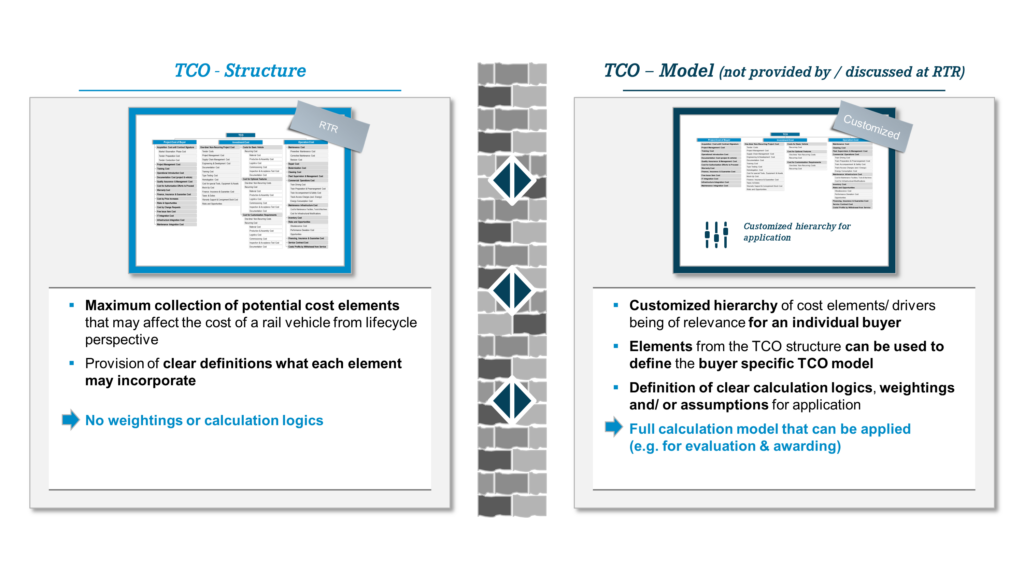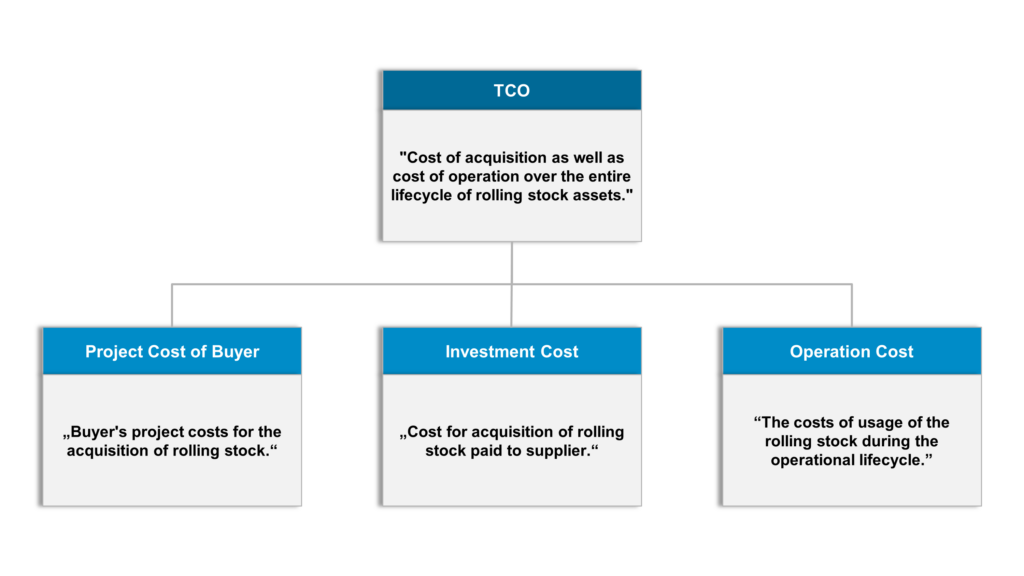
WP 02 – TCO Structure
Overall Context
Description of a generic TCO structure
With respect to Work Package 02, the Initiative aimed to create a common generic conceptual structure for the topic of Total Cost of Ownership. As the initial acquisition price is usually the only transparent indication of the cost of a rolling stock, it usually goes in hand with a variety of further “hidden” cost items that arise throughout the usage and lifecycle of the asset. From an economic perspective, it is desirable to consider all total costs throughout the ownership and/ or lifecycle of an asset, to avoid suboptimal tender evaluations for a buyer.
Results of this work package could contribute to a harmonized way of understanding for the entire industry of potentially relevant cost items over a lifecycle of rolling stock (without extending to any values/ weighting of items). The developed generic structure represents an overview of potentially relevant cost items for a rolling stock, which will need to get further customized, amended or detailed by any buyer/ operator individually or for any tender. Any buyer/ operator may transfer the structure into a TCO model. It is available and recommended for usage by any buyer of rolling stock assets, although it has been developed with background of the European market.
Being part of the overall RTR Initiative, results in this Work Package have been developed according to the RTR-compliance mechanism (Antitrust Council).
Documents about TCO Structure
To download the documents, please log in.
Objectives
Generic description of all potential cost items that may get incurred until a product’s end-of-life
In general, the term Total Cost of Ownership (TCO) describes a financial evaluation or management accounting approach that intends to evaluate the total economic value of an asset over the course of its entire lifecycle. The RTR TCO structure contains no weighting. If a buyer wants to weight the cost items, the buyer must do that for himself.
In contrast to a focused evaluation of a product’s pure one-time acquisition and investment cost or sales price, the concept of TCO thus considers all cost items that may get incurred until a product’s end-of-life. Exemplary aspects that may get incorporated in a specific TCO evaluation can for example be the cost for the regular maintenance of an asset, expected repair costs, but also all costs that are required to operate the asset until its disposal or reselling (i.e. energy costs, insurance costs, …).
The TCO structure by the RTR initiative lists all to date generally possible cost elements over the whole product lifecycle, from procurement until disposal or reselling. It is always necessary for the operator or buyer to transform the TCO structure to an applied TCO model which fits to the operator’s processes, financial structures or maintenance and operational concepts (see Figure 1 for illustration).
It is to mention, that the TCO structure is not a price sheet in a tender. A price sheet may contain or cover different cost elements of the TCO structure, and it is explicitly not the goal within RTR to design a price sheet with the TCO structure which could be used directly in a tender.
In line with this generic conceptual idea and a particular focus on the railway industry, the RTR Initiative defines Total Cost of Ownership as the “Cost of acquisition as well as cost of operation of the entire lifecycle of rolling stock assets.”

TCO & Main Cost Categories
High Level Overview and Definitions
In its essence, the developed TCO Structure of the RTR Initiative is consisting of three main cost categories, as depicted in Figure 2. All three categories have been iteratively developed in the group of RTR Initiative representatives and are defined as following:
- Project Cost of Buyer
“Buyer’s project cost for the acquisition of rolling stock.”
- Investment Cost
“Cost for acquisition of rolling stock paid to supplier.”
- Operation Cost
“The costs of usage of the rolling stock during the operational lifecycle.”

For each cost item an agreed definition has been documented, incl. generic examples of cost elements, drivers and influence parameters:
- The TCO-Structure depicts a (to date) maximum possible list of items that may get individually used by any party at application
- The structure creates a common understanding and coherent language what is meant by each item
- The structure and application guideline do not provide for any weightings or calculation schemes
In the download section, you can find the RTR Initiative’s TCO structure, incl. detailed description by means of a tabular overview of the three main cost categories.
